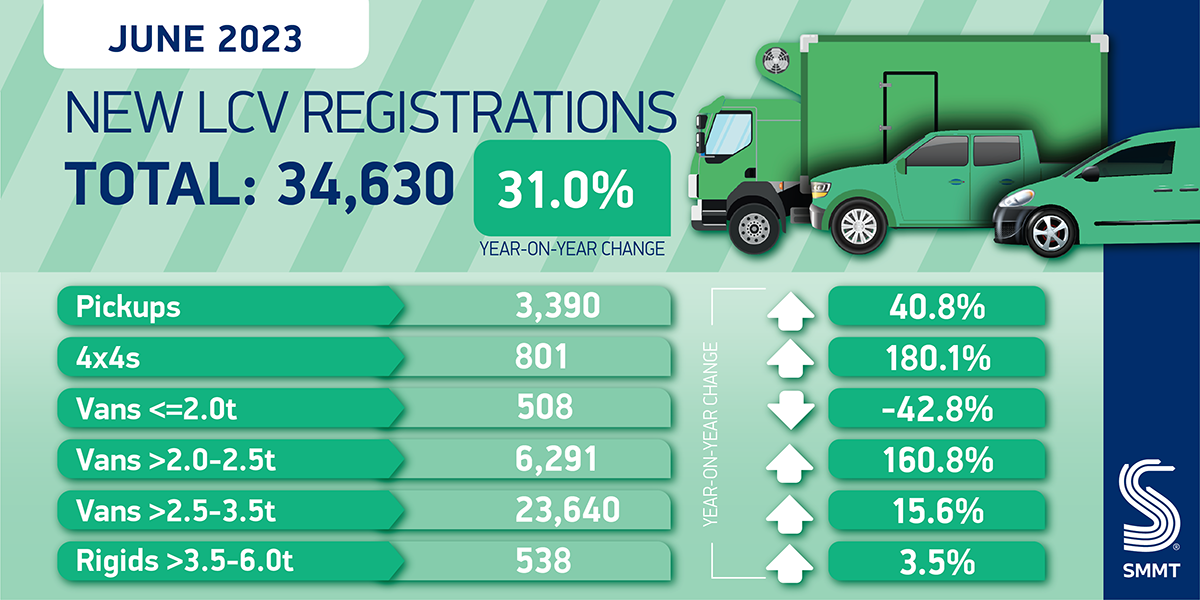- New light commercial vehicle market records best first half year since 2019, up 17.7% as supply chain shortages ease.
- Demand for the latest vans rises by 31.0% in June to reach 34,630 units, rounding off six consecutive months of growth.
- Battery electric volumes increase by 8.7% in first half of the year, but uptake falls by -11.9% in June to 1,775 units.
SEE LCV REGISTRATIONS BY BRAND
DOWNLOAD PRESS RELEASE AND DATA TABLE

The UK new light commercial vehicle (LCV) market has risen for the sixth consecutive month, growing by 31.0% to 34,630 units in the best June since 2019, according to the latest figures published today by the Society of Motor Manufacturers and Traders (SMMT). 169,926 new vans, pickups and 4x4s were registered in the first half of 2023, up 17.7% compared with the same period last year, as once persistent supply chain shortages ease.

Registrations of the largest LCVs, weighing greater than 2.5 to 3.5 tonnes, rose by 15.6% to 23,640 units to account for 68.3% of the market in June, while registrations of medium-sized vans weighing more than 2.0 to 2.5 tonnes reached 6,291 units, up 160.8%. Conversely, lighter vans weighing less than or equal to 2.0 tonnes fell -42.8%, the only segment to decline and the one which has seen demand consistently fall as operators favour larger workhorses with the potential for greater cost efficiencies. Pickups and 4x4s, meanwhile, increased by 40.8% and 180.1% respectively.

Despite overall growth, demand for battery electric vans (BEVs) fell -11.9% in the month to 1,775 units, even with a growing number of models on the market. This brings the total of all electric vans registered so far this year to 8,803 units, a year on year increase of 703 but a market share decline to 5.2% in the year to date.1 Given that commercial vehicles are integral to keeping Britain on the move and subject to the same end of sale date as the much further progressed passenger car market, urgent action is needed to accelerate uptake ahead of a zero emission vehicle mandate set to be implemented in just six months’ time.

Mike Hawes, SMMT Chief Executive, said,
As we reach the year’s midway mark, the surge in light commercial vehicle registrations is good news and delivers continued optimism to the market. The fall in electric van uptake just at the time when we need it to grow is, however, very concerning. Despite the continued availability of the plug-in van grant, more needs to be done to give operators the confidence to make the switch. This means a long-term plan which supports purchase and helps overcome some of the barriers to the installation of van-suitable charging infrastructure, given the unique needs of this sector.

The paucity of charging points that are suitable in both size and location for van use remains a major obstacle to the take up of these new technology vehicles. Charge point operators want to invest but obstacles such as an outdated planning system and delays to grid connections must be overcome to ensure infrastructure can be built ahead of need. With high energy prices also a deterrent to the transition, urgent measures to drive down the cost of charging are required to enable the switch to be as cost effective as possible.
Notes to editors
1. Year-to-date, June 2022: 5.6%
